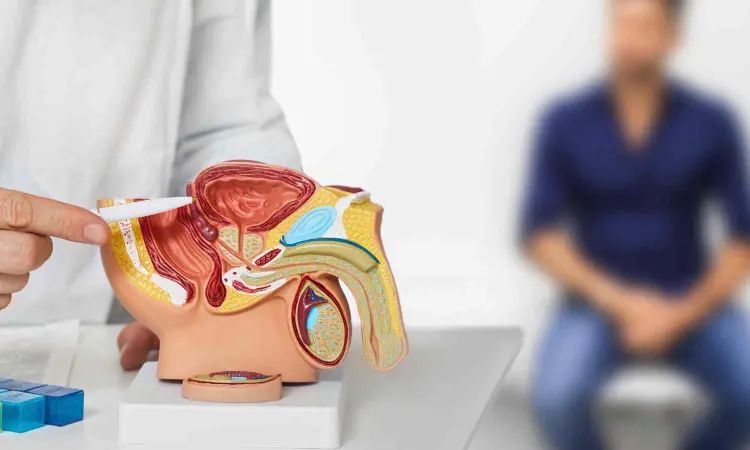- Home
- Medical news & Guidelines
- Anesthesiology
- Cardiology and CTVS
- Critical Care
- Dentistry
- Dermatology
- Diabetes and Endocrinology
- ENT
- Gastroenterology
- Medicine
- Nephrology
- Neurology
- Obstretics-Gynaecology
- Oncology
- Ophthalmology
- Orthopaedics
- Pediatrics-Neonatology
- Psychiatry
- Pulmonology
- Radiology
- Surgery
- Urology
- Laboratory Medicine
- Diet
- Nursing
- Paramedical
- Physiotherapy
- Health news
- Fact Check
- Bone Health Fact Check
- Brain Health Fact Check
- Cancer Related Fact Check
- Child Care Fact Check
- Dental and oral health fact check
- Diabetes and metabolic health fact check
- Diet and Nutrition Fact Check
- Eye and ENT Care Fact Check
- Fitness fact check
- Gut health fact check
- Heart health fact check
- Kidney health fact check
- Medical education fact check
- Men's health fact check
- Respiratory fact check
- Skin and hair care fact check
- Vaccine and Immunization fact check
- Women's health fact check
- AYUSH
- State News
- Andaman and Nicobar Islands
- Andhra Pradesh
- Arunachal Pradesh
- Assam
- Bihar
- Chandigarh
- Chattisgarh
- Dadra and Nagar Haveli
- Daman and Diu
- Delhi
- Goa
- Gujarat
- Haryana
- Himachal Pradesh
- Jammu & Kashmir
- Jharkhand
- Karnataka
- Kerala
- Ladakh
- Lakshadweep
- Madhya Pradesh
- Maharashtra
- Manipur
- Meghalaya
- Mizoram
- Nagaland
- Odisha
- Puducherry
- Punjab
- Rajasthan
- Sikkim
- Tamil Nadu
- Telangana
- Tripura
- Uttar Pradesh
- Uttrakhand
- West Bengal
- Medical Education
- Industry
Low-dose-rate brachytherapy improves recurrence-free survival for recurrent prostate cancer: Study

A new study published in the British Journal of Urology International found that salvage low-dose-rate brachytherapy (LDR-BT) provides a higher recurrence-free survival (RFS) than high-dose-rate brachytherapy (HDR-BT) for radio-recurrent prostate cancer.
Local salvage therapy is rarely used, despite the fact that local tumor persistence following external beam radiation therapy (EBRT) for prostate cancer is not uncommon. Salvage prostatectomy, cryotherapy, high intensity focused ultrasound, and whole or partial gland high dose rate (HDR) or low dosage rate (LDR) brachytherapy are some of the available alternatives. The majority of outcomes that have been published are retrospective from a single center.
Androgen deprivation, which can be given on a delayed or intermittent basis, is still the most popular method because of the advanced age of the patient, co-morbidities, and/or a fear of toxicity. Thus, to summarize the effectiveness and toxicity of salvage low-dose-rate brachytherapy and compare these results with the published data on salvage high-dose-rate brachytherapy, Shaoqin Xie and colleagues carried out this study.
This study primarily looked at recurrence-free survival using salvage LDR-BT across subgroups, searching PubMed and EMBASE for articles published up until May 2024. As a supplementary goal, this research also contrasted unfavorable occurrences and RFS with HDR-BT. Using a semi-automated tool called WebPlotDigitizer and a brand-new, slick R application, this study recreated survival curves.
A total of 31 studies in all satisfied the requirements for salvage LDR-BT inclusion. For patients treated with salvage LDR-BT, the 2-, 3-, and 5-year rates were 84.6%, 74.3%, and 63.5%, respectively, with a median RFS of 131.6 months. Positive recurrence-free survival parameters included a lower median age and a larger proportion of adjuvant androgen deprivation therapy.
Salvage LDR-BT showed better recurrence-free survival for all patients when compared to HDR-BT. In particular, compared to HDR-BT, salvage LDR-BT demonstrated better recurrence-free survival for patients with a median age of ≥70 years at recurrence, a median span of ≥70 months between primary treatment and salvage therapy, a median pre-salvage prostate-specific antigen level of ≥5 ng/mL, and a proportion of adjuvant ADT of ≥53%.
In contrast to HDR-BT, LDR-BT was linked to a greater incidence of serious gastrointestinal and genitourinary (GU) toxicities. Overall, salvage LDR-BT appears to produce better recurrence-free survival in some cohorts than HDR-BT, but it also has a higher risk of severe GI/GU toxicities.
Source:
Xie, S., Liu, J., Shen, B., Xu, H., & Ni, J. (2025). Salvage low‐dose vs high‐dose brachytherapy for radio‐recurrent prostate cancer. British Journal of Urology International. https://doi.org/10.1111/bju.16639
Neuroscience Masters graduate
Jacinthlyn Sylvia, a Neuroscience Master's graduate from Chennai has worked extensively in deciphering the neurobiology of cognition and motor control in aging. She also has spread-out exposure to Neurosurgery from her Bachelor’s. She is currently involved in active Neuro-Oncology research. She is an upcoming neuroscientist with a fiery passion for writing. Her news cover at Medical Dialogues feature recent discoveries and updates from the healthcare and biomedical research fields. She can be reached at editorial@medicaldialogues.in
Dr Kamal Kant Kohli-MBBS, DTCD- a chest specialist with more than 30 years of practice and a flair for writing clinical articles, Dr Kamal Kant Kohli joined Medical Dialogues as a Chief Editor of Medical News. Besides writing articles, as an editor, he proofreads and verifies all the medical content published on Medical Dialogues including those coming from journals, studies,medical conferences,guidelines etc. Email: drkohli@medicaldialogues.in. Contact no. 011-43720751


